Having run a number of my AR-15s in 5.56 and 300 BLK with suppressors over the years, I’m no stranger to the unpleasant gas and powder blowback in my eyes that comes along with suppressed experience. So, when I made the decision to go all-in and order an integrally suppressed AR-15 upper in 5.56, I knew I was going to be spending some time figuring out how to reduce that blowback to some extent or another.
To introduce some urgency to the situation, I decided my goal is to make this integrally suppressed AR-15 my go-to rifle. Which means I’m going to practice regularly with it and it’s going to get a lot of use.
If you have never shot a suppressed AR-15 in 5.56, much of the gas and unburnt powder that normally comes out the muzzle when you shoot unsuppressed, gets blown back into the upper receiver. The problem is that gas has to come out somehow.
Unfortunately, the primary places for the gas to escape are located directly under your eyes and nose; mainly the spaces around the charging handle where it locks into the upper receiver and around the forward assist where it’s inserted into the upper.
The gas isn’t just unpleasant, it actually burns your eyes and forces your eyelids to close. As you would imagine, the quicker and more frequently you pull the trigger, the worse it gets.
Regular shooting glasses don’t keep all the gas out of your eyes. It tends to go right in under and around the lenses. The lenses can actually keep the gas trapped inside the glasses making matters even worse.
Only a pair of ski or swim goggles that seal to your face will prevent the gas from coming into contact with your peepers. The obvious solution is clearly a pair of tactical ski goggles, but that’s not the route I chose to take :).
Just over a month ago, my tax stamp finally came in and I was able to pick up my 16” integrally suppressed upper, the Thompson Machine SuperNova chambered in 5.56.
When I ordered my SuperNova upper, I decided I wanted to have as much barrel length as possible so I wouldn’t lose too much velocity to a short barrel. I also didn’t want the suppressed upper to be any longer than a traditional 16” AR-15 carbine.
Thompson Machine recommended I go with their 11.5” barrel; with the integral suppressor, it comes in right around 16”. Another benefit of a 16” integrally suppressed upper aside from maintaining some velocity, at 16” the suppressed upper only requires one tax stamp because it’s only considered a suppressor by the ATF, and not a short barreled rifle (SBR). Had I gone with a shorter barrel version of the SuperNova, it would be a two tax stamp upper because it would be considered both a suppressor and an SBR.
The Thompson Machine 16” SuperNova Integrally Suppressed Upper in 5.56
More length means also means there’s more room for the expanding gas to go toward the muzzle, therefore, less gas back into the upper receiver and blowback in your face. So, choosing the 16” SuperNova over a shorter version was actually my first step towards reducing blowback from my integrally suppressed upper.
When I placed my order for the SuperNova, I certainly could have specified certain parts be used that would aid in blowback reduction. But I specifically chose a standard build, because I wanted to figure out what parts are most effective in reducing blowback on my own.
When you start to research how others have reduced blowback on their suppressed AR-15s, you will quickly see there are a fair number of options out there. As you dig deeper you will notice the options (parts) and modifications, are designed to do one of two things:
1) Reduce the amount of gas coming back into the upper receiver
2) Redirect the gas away from your face (eyes and nose in particular)
Doing either of these two things will help reduce the amount of blowback in your face. Doing both will reduce it further.
Initially, my hope was to completely eliminate blowback altogether. By experimenting with different parts and modifications, I learned the total elimination of blowback isn’t quite possible, but you can get pretty darn close with the right combination.
I waited until I was able to pick up my rifle from my Class III Dealer before I purchased any parts; I wanted to see how much blowback I was dealing with on SuperNova upper with standard mil-spec parts (bolt, bolt carrier, charging handle, etc). After a few rounds, my closed and tearing eyes made it clear I had my work cut out for me.
Over the last few years I have seen quite a few “enhanced” bolt carriers, bolts, and bolt carrier groups (BCGs) on the market. Some of these enhanced BCGs are simply mil-spec BCGs with a nicer finish that make the BCG easier to clean.
Other enhanced bolts and BCGs are made with a tougher steel alloy than mil-spec calls for, or parts that are machined to tighter tolerances.
Finally, some enhanced carriers and BCGs actually tout the benefits of reducing blowback when shooting suppressed. These are the types of enhanced BCGs we will be talking about below.
Like most of you, I don’t have an unlimited budget for firearms and parts. I was trying to be as cost conscious as possible when buying parts for this project.
The prices varied considerably for the type of enhanced carrier I was looking for. Some just came with the carrier, some were the compete BCG. I was surprised to see some of the stand-alone enhanced carriers were more expensive than some of the enhanced BCGs (complete with carrier and bolt).
After looking at the numerous options, there were two I was deciding between; the CMC Enhanced Bolt Carrier Group (complete BCG), and the GemTech Suppressed Bolt Carrier (carrier only).
Both claim to help reduce blowback by increasing dwell-time; delaying the unlocking of the bolt when firing, which allows expanding gases more time to exit the bore, in turn reducing the amount of gas entering the upper receiver.
These two carriers go about increasing dwell time in slightly different ways. The CMC carrier does it by adding an extra gas port to the carrier and increasing the size of the ports. The GemTech carrier has a valve that opens and closes; when closed the flange is in the “U”, or un-suppressed position, and when opened it is in the “S”, or suppressed position. In the S position more gas escapes though the carrier and slows down the unlocking of the bolt, which increases dwell-time and allows more gas to escape through the muzzle.
There are some other benefits of increasing dwell-time other than reducing blowback. These include increasing reliability by preventing bolt-over malfunctions, reducing recoil, and reducing stress on the parts of the rifle in general.
Differences among the Bolt Carriers
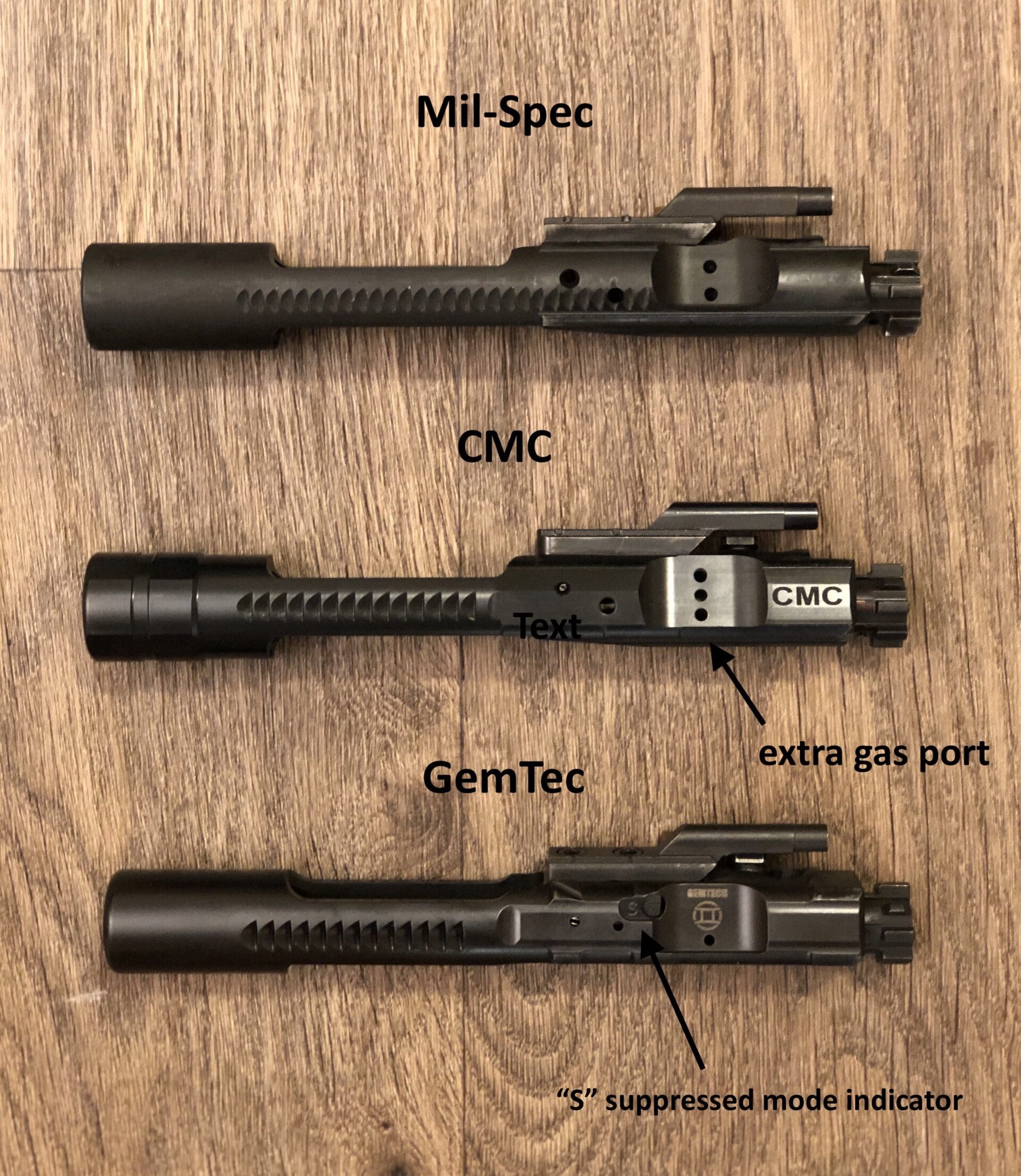
The Valve Flange on the GemTech for switching from Unsuppressed to Suppressed Firing
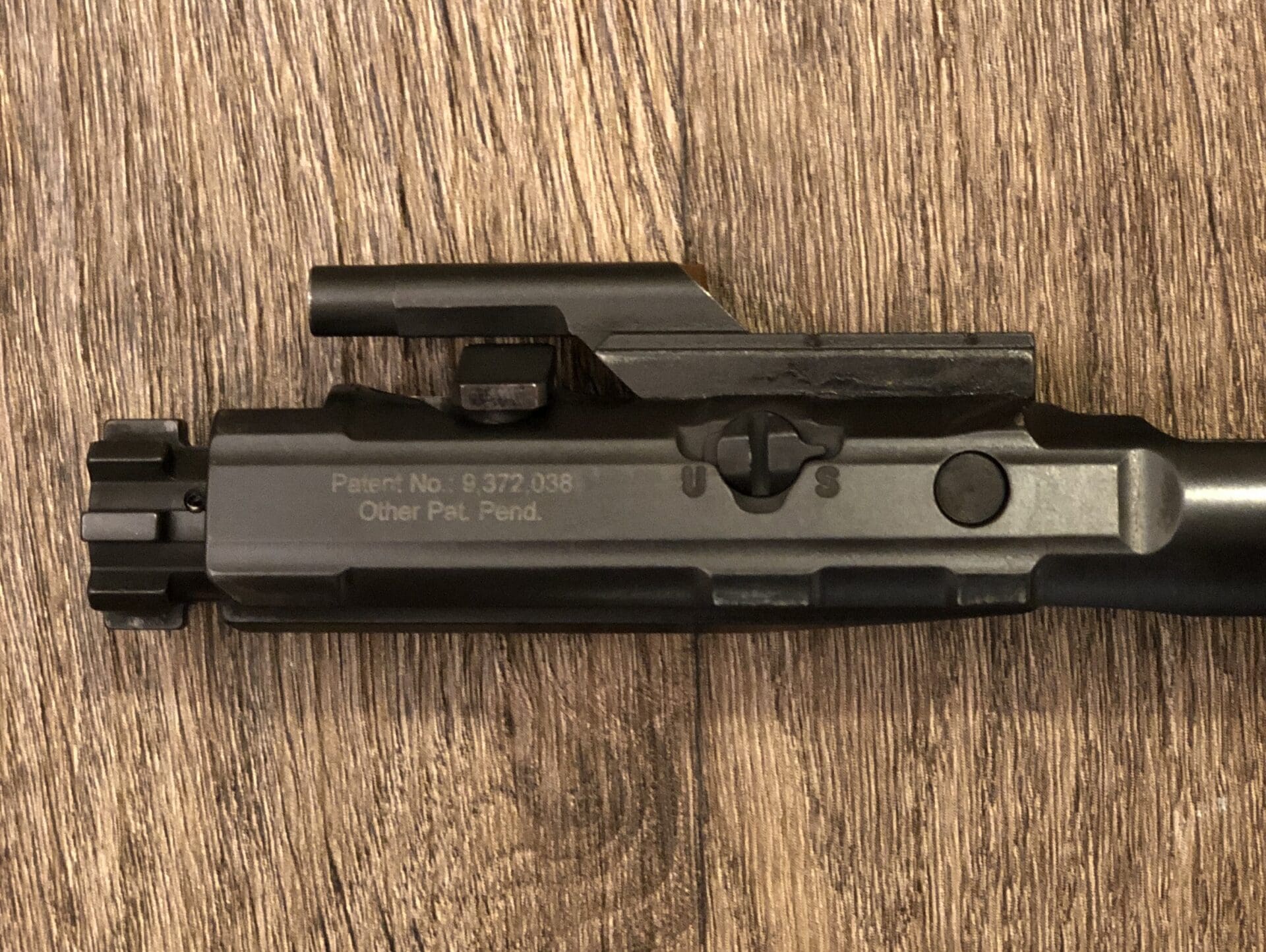
As you can see in the picture above, both the CMC and GemTech carriers have a nice black nitride finish which is known for its durability. It’s also much easier to clean than the standard mil-spec finish.
A closer look will also reveal the machine work on these two carriers is well done and clean. Some extra machining is done on these carriers as well around the contact points which decreases friction and wear.
Since the CMC comes as a complete BCG and the MSRP is $199.99, I decided to try it over the $249.99 GemTech, which is only the carrier. While the CMC turned out to be a a good BCG, my experience with it tells me the enhancements have more to do with the finish and machine work than it does blowback reduction.
When shooting with the CMC BCG, I noticed there was maybe a little less blowback, but not enough to warrant the purchase of the CMC unit for blowback reduction purposes.
If you’re interested in a nicely finished and machined AR-15 bolt carrier and bolt, definitely take a look at the CMC. But if your primary goal it to reduce blowback, look elsewhere.
That’s exactly what I did. Undaunted and still determined to eliminate blowback, I went ahead and ordered the GemTech Suppressor Bolt carrier, and I’m glad I did.
An hour after the GemTech carrier showed up at my office, I lubed it up, switched the valve flange on the carrier from “U” to “S”, dropped it in my SuperNova upper and headed to the range.
The difference in blowback was immediately apparent. Not only did it reduce blowback somewhere around 60% in my estimation, you could also feel the difference in gas pressure in the upper receiver.
With the standard mil-spec carrier, or the CMC bolt carrier group, for lack of a better way to describe it, you could just feel the upper take on the pressure of the gas filling the upper receiver when firing. With the GemTech carrier, you don’t feel that at all. It feels like you’re firing an unsuppressed AR-15. It’s a much crisper and cleaner experience.
While the 60% reduction in blowback with the GemTech carrier is very significant, the 40% of remaining blowback still hurts my eyes quite a bit, especially when shooting a few strings of rapid-fire. Since my goal is to make this my go-to rifle and I don’t plan on shooting with my back to the wind 100% of the time, I had more to do.
Earlier, I had mentioned there are two ways to reduce blowback on a suppressed AR-15. With the GemTech carrier I had addressed the first way; reducing the amount of gas blowing back into the upper. But I had yet to do anything regarding the second option; redirecting the gas away from my face.
Since most of the gas that hits your face comes from the rear of the receiver where the charging handle locks into place, as well as the space around the forward assist where it fits into the upper receiver, it stands to reason the parts or mods to redirect the remaining blowback would need to address those areas.
Let’s start with the parts that address the area at the rear of the receiver where the charging handle locks into place.
There are several charging handles available that claim to redirect escaping gas from the rear of the receiver and away from you face. After reading a number of reviews and comparisons of these charging handles, only one seems to really work particularly well; the Gas Buster Charging Handle from PRI.
The Gas Buster can be easily found online in the $90 range. You can see on the top and bottom of the rear of the Gas Buster there are channels and extensions that are designed to redirect gas. The standard Mil-Spec handle doesn’t have these features.
Gas Buster Charging Handle versus Mil-Spec Charging Handle: Top View
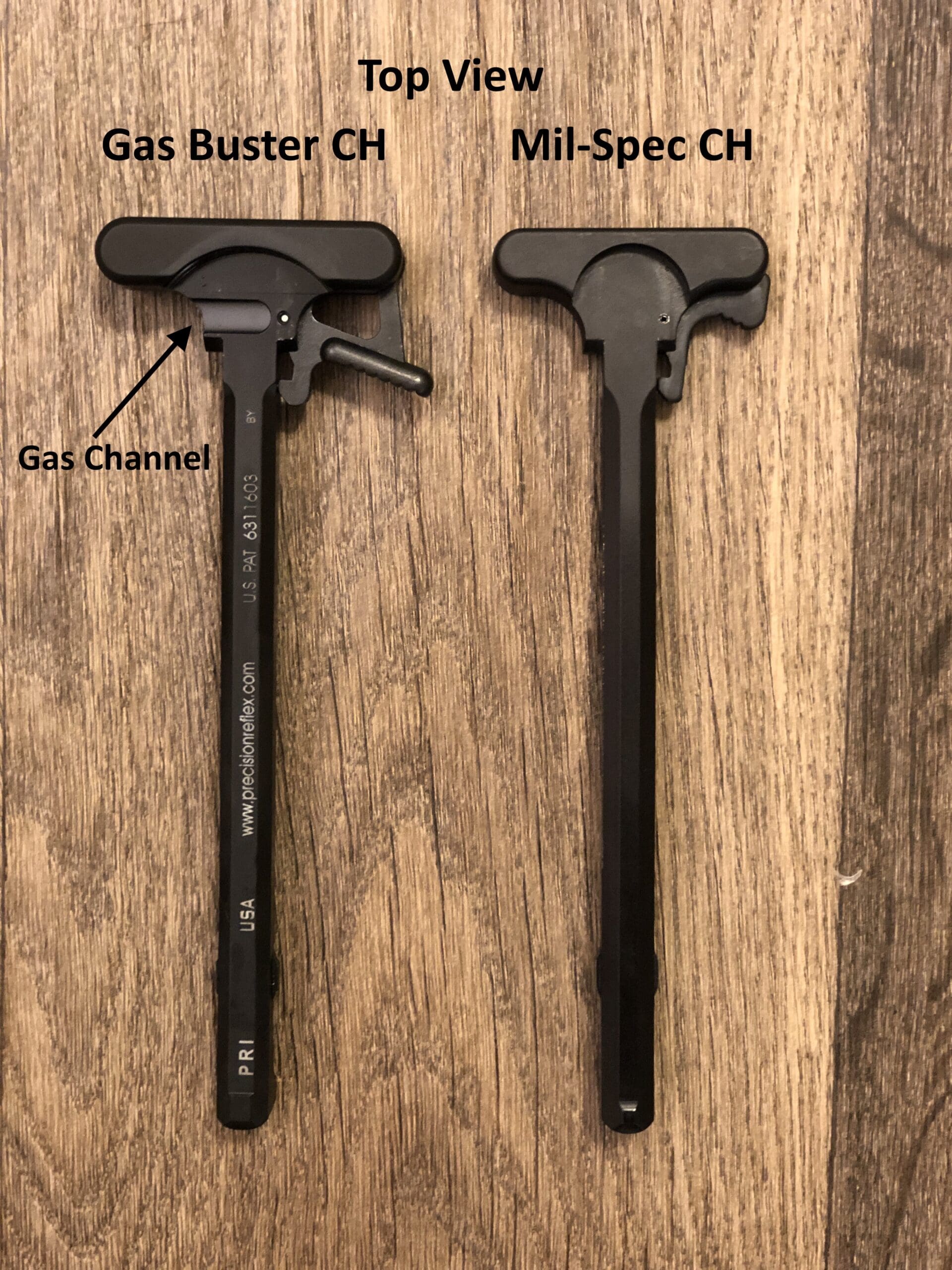
Gas Buster Charging Handle versus Mil-Spec Charging Handle: Underside View
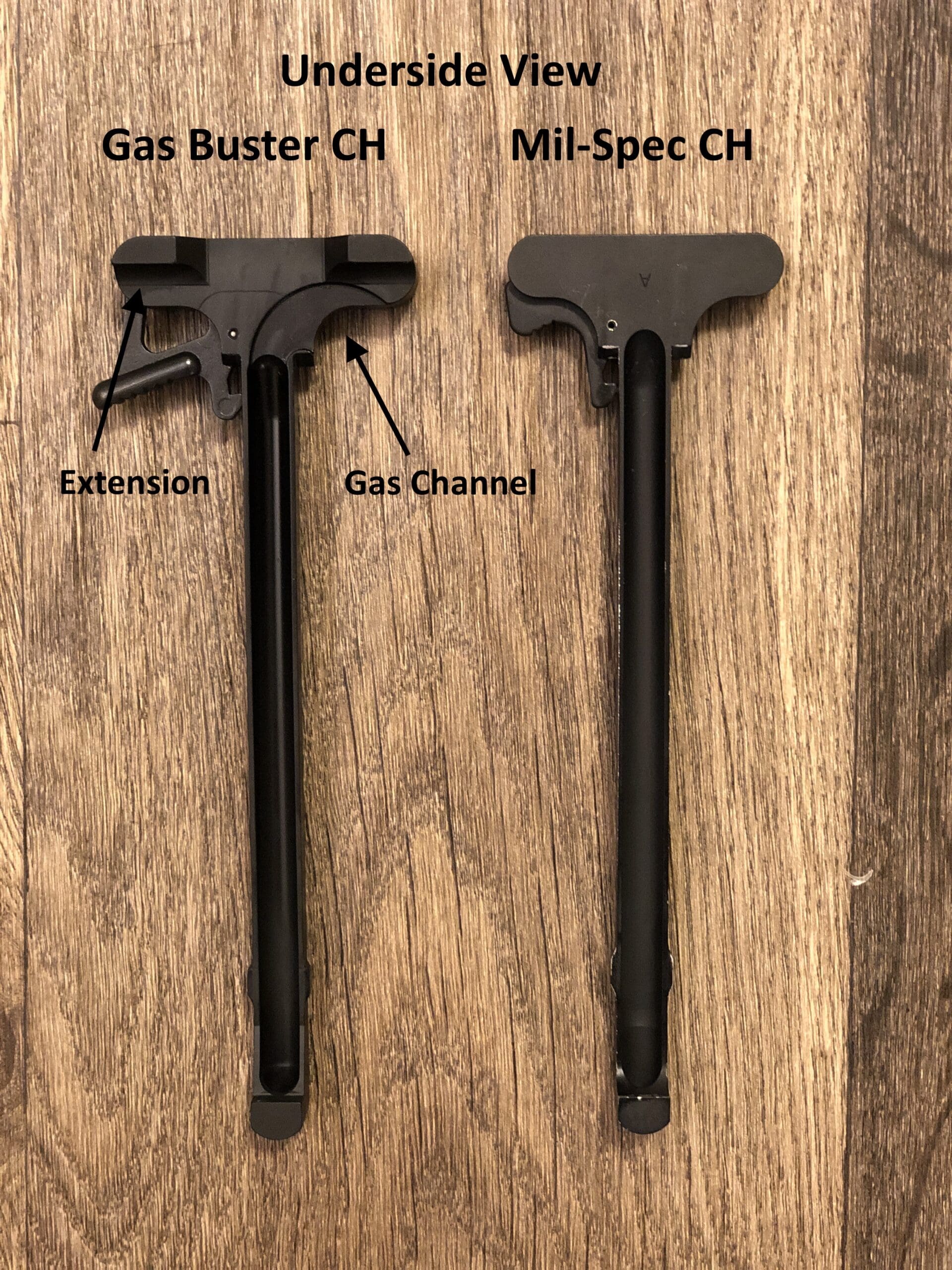
There is only one part that I know of that helps redirect the gas coming from around the forward assist, and it’s the last part I purchased for this project. It’s called the AR Gas Vent made by a company called Simplistic Shooting Solutions.
It’s basically a dummy forward assist that is hollow and has a vent cut into it which redirects the gas coming out from the forward assist area. The only downside is that while the AR Gas Vent looks like a forward assist, it’s not. It’s locked into place and you lose your forward assist capability.
I don’t know about you, but I have never once used my forward assist in all the years I have owned AR-15s. However, if I was ever to need to use one, it would probably be with a suppressed rifle.
With all the fouling blowing back into the chamber it’s certainly possible for dirt to build up quickly and interfere with the forward motion of the bolt carrier.
That said, I don’t think my rifle will ever get dirty enough for that to happen. I shoot quality ammo and keep my guns clean and well-lubed. So, I decided I was comfortable losing my forward assist capability and ordered the AR Gas Vent which, by the way, is only available two places online: Ranier Arms and Weapon Outfitters. The price is $38.99 at both places.
AR Gas Vent
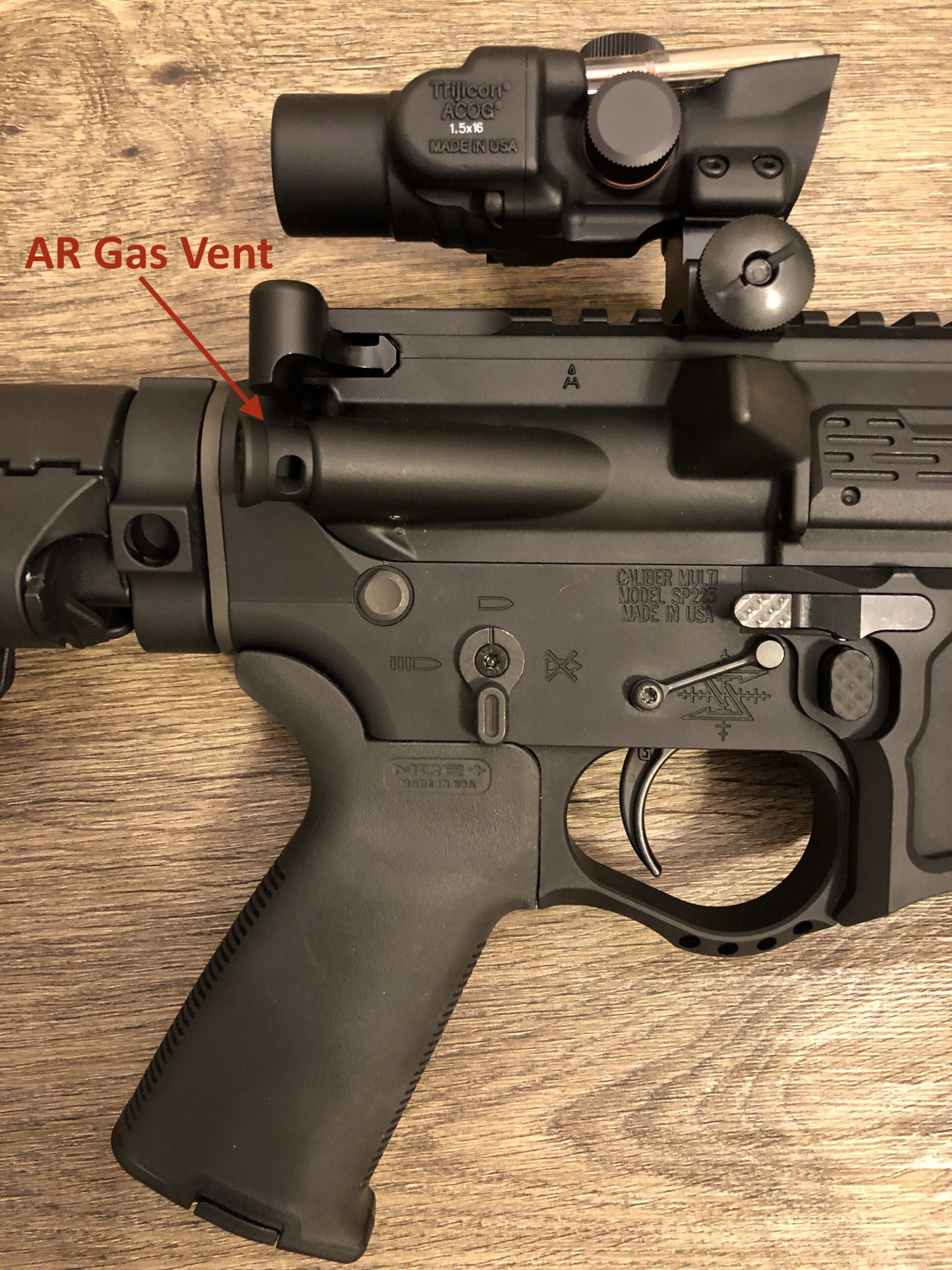
The Gas Buster charging handle and AR Gas Vent arrived at my office on the same day. I went ahead and knocked out the roll pin that holds the forward assist in place, inserted the AR Gas vent and put the roll pin back in.
It took no more than a few minutes to install. Just make sure you have a 3/32 punch to knock out and re-install the roll pin that holds the forward assist in place.
I didn’t install the Gas Buster charging handle just yet. I also removed the GemTech bolt carrier and replaced it with the original standard mil-spec BCG that came with the upper. I did this because I wanted to see how effective the AR Gas Vent was on its own without any other modifications or parts.
After installing the Gas Vent and putting the standard BCG back in the rifle, I hopped in the car and headed to the range. I loaded up my SuperNova and fired 10 rounds.
Much to my surprise the AR Gas Vent, the least expensive part/modification used, vented what seemed to be about 30% of the gas down and away from my face. That’s pretty good for such an inexpensive and easy modification. But, when firing you could still feel the receiver fill up with gas as I discussed earlier, which didn’t happen when the GemTech bolt carrier was in the upper.
The amount of gas I was getting in my face was noticeably less than with the standard set-up, but it was still too much for my eyes. There is no way I would do well in a tactical carbine class with just the AR Gas Vent.
I then went ahead and removed the mil-spec charging handle and replaced it with the Gas Buster charging handle. I then sealed the AR Gas Vent with some duct tape so I could just test the Gas Buster on its own. Then I fired off a dozen rounds or so.
The Gas Buster did exactly what it was designed to do, it redirected a fair amount of the gas coming out of the charging handle slot in the back of the receiver away from my face. I would say at least 50% of the blowback was being redirected away from me by the channels machined into the charging handle.
I then took the duct tape off the AR Gas Vent and fired another dozen rounds. The two parts worked nicely together redirecting considerably more than half the gas away from my face, but I was still getting 30% to 40% of the blowback with these two parts installed. That’s still enough gas to force my eye lids to close when shooting rapid-fire strings.
Finally, for the ultimate test, I pulled the mil-spec BCG out and replaced it with the GemTech suppressor carrier. I filled up my 20-round mag and fired 10 rounds. Then another 10 rounds. Then I smiled.
To my pleasant surprise my eyes were not uncontrollably blinking. There was still a little gas coming back, but not so much that I couldn’t keep my eyes open. In fact, had I been outside and the air was moving around a little bit, I probably wouldn’t have even noticed the gas.
I am confident I was able to eliminate around 90% of the blowback with the addition of the GemTech carrier, Gas Buster charging handle, and the AR gas vent.
The other bonus, which I mentioned before, with the GemTech carrier in place, you don’t feel the upper taking on the pressure from the load of gas after each shot. It feels like you are shooting an unsuppressed AR-15.
With the modifications I have made, virtually eliminating blowback, I would have no problem shooting a few hundred rounds at the range with the SuperNova or making it through a 3-day carbine class. I suspect that also has something to do with the fact that I started out with a quality suppressed upper to begin with.
From the first time I shot the Thompson Machine integrally suppressed SuperNova, through all the testing with the different parts, I didn’t have a single failure of any kind. Over 700 rounds have gone through the rifle without a hitch.
I used quite a few different types of ammo as well. And the 16” SuperNova is, without question, the quietest suppressed AR-15 chambered in 5.56 I have ever come across. With its stainless steel barrel and all titanium suppression system, it is built to last.
The modifications I made will also help reduce stress and wear on all the parts of the rifle, which will contribute to its longevity. The little bit of accuracy testing I have done with the SuperNova has been outstanding as well.
If you have an AR-15 that you run suppressed, or an integrally suppressed upper, I highly recommend you make some — or better yet, all — of the modifications discussed here. You will be a very happy rifle shooter. I know I am.
The Thompson Machine SuperNova 5.56 Integrally Suppressed Upper has Proven Quite Accurate Thus Far



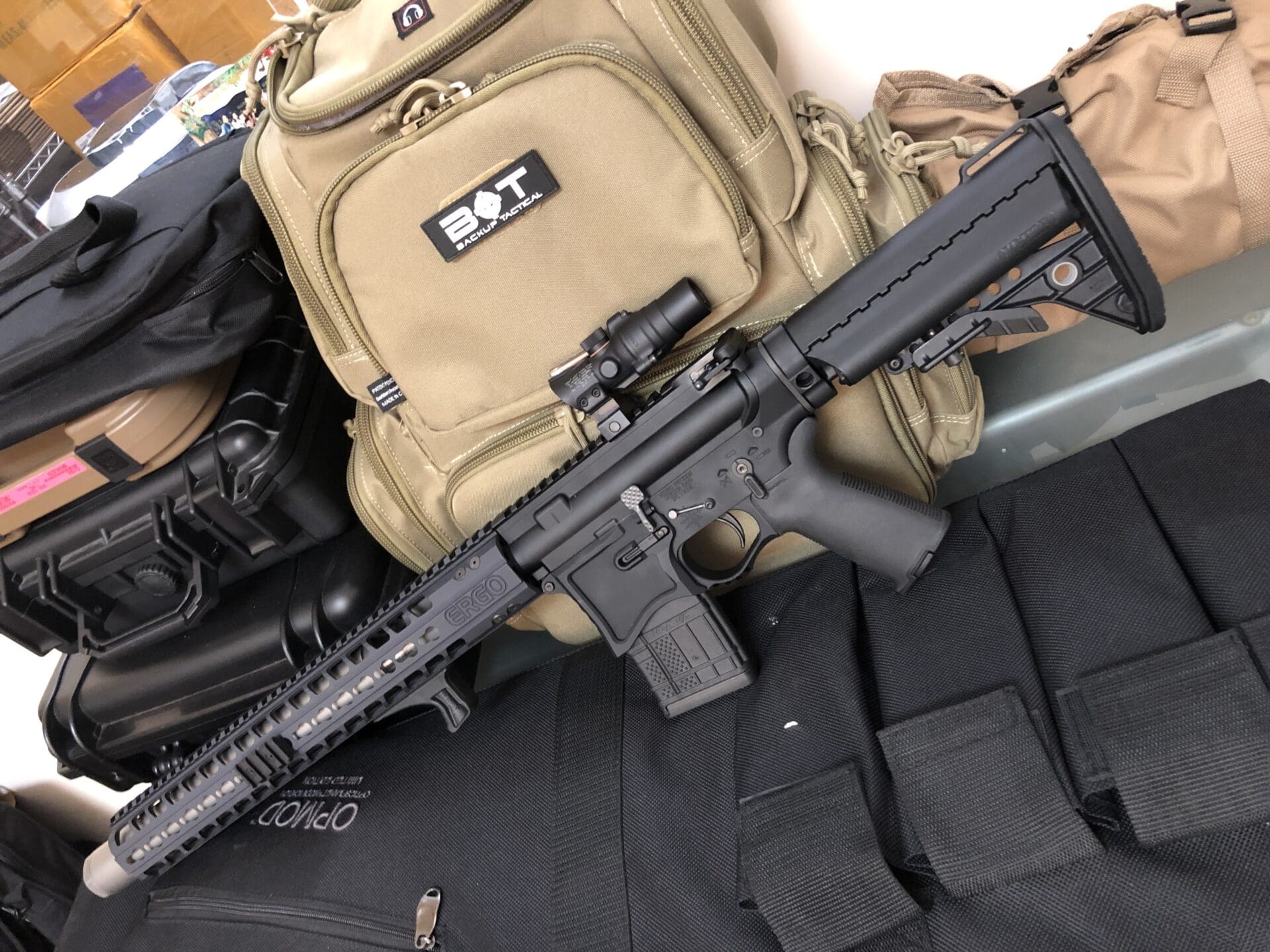



JESUS, that’s a lot of words for two upgrade to deflect gas blow back.
Three upgrades.
Buy a piston, problem solved.
I take it you have never shot a suppressed piston AR rapidly before? The blowback comes from the chamber, not the gas system. The inherent problem with suppressing an AR is the charging handle location directing the blowback into your face.
But then you get a puff of gas coming out of the hand guards.
watch the Military Arms channel suppressor series (video 1). Piston blow-back greatly increases noise, and I believe he said you still get gas.
Adjustable gas block takes care of a crap ton of that extra gas and gets you tuned exactly where you want to be for various loads, suppressed, unsuppressed, etc.
Then make your own gas buster with a line of black RTV in the circular portion of your CH. There’s a video out there on this simple DIY.
I pretty much only shoot suppressed at this point and do not have issues with gas to the face. Still get a more carbon coming from the chamber, but not in the face.
This is exactly what I was thinking. The only reasonable way to mitigate the gas in the upper receiver is not to have it in the first place. I shoot numerous suppressed gas guns, and they all have tunable gas systems. This prevents the excess heat/fouling/wear on your components.
Adding an adjustable gas blocks also adds one more potential failure point.
Appreciate this article. More good info here than I’ve ever seen elsewhere. You’ve educated me and left me knowing more than I knew before.
Now…if I could only *have* a legal suppressor here in CA…
Good review. Genuinely learned some things. Though I’d like to add:
“reduce blowback by increasing dwell-time; delaying the unlocking of the bolt when firing, which allows expanding gases more time to exit the bore, in turn reducing the amount of gas entering the upper receiver.“
Sounds to me like a good argument in favor of the Teutonic engineered, delayed roller blowback 😉
Yeah, or a piston system instead?
Or a piston system with full rifle length gas port, dialed down correctly.
I have a POF P308 SPR AR-10 (18.5″ barrel, full length gas port) that runs with almost no blowback at all when running suppressed.
Those short gas port (pistol, carbine) will NEVER run as clean as the original AR Stoner length systems.
Delayed roller blowback is filthy, and doubly so with a suppressor.
That’s because many of them also use positive ejection of the spent cartridge. Gas is allowed to flow around the outside of the case to unseal it from the chamber walls.
That’s a lot of evil looking military grade tactical assault rifles. Did this pass all background checks?
Let’s go back to me most mind blowing announcement of the century, Glock’s .22lr handgun! Soooooo excited.
You have no idea how well your user name describes you, son.
A shitpost from something that lives in shit… 😉
Geoff, have you noticed a large number of brand new usernames washing up on TTAG over the past few days, appearing once or twice, spouting nonsense, and never to be seen again?
Methinks we have a crafty troll us that has recently discovered the site and is testing his guerilla keyboard tactics. Definitely isn’t Vlad. Someone else suggested Pg(two), but that would involve arguing about vaxx…
Yeah, an uptick is about right…
Could be some of the university kids over my way doing wokeness projects to combat white supremicy …….. would be a little confused why here instead of the chans but some don’t like being called mean names.
The paid trolls hang out at any site that is pro liberty or pro truth. the idea is to make themselves APPEAR to be both pro gun (in the case of this website) and as crazy as loons, to make all truth tellers look bad.
This is what liars do when their lies begin to fail. Their fallback position, when they can no longer get people to believe the lies about their good intentions, is to tell ever more egregious falsehoods, while PRETENDING to be their opponents.
Note that both tactics are pure deceptions. It behooves all thinking men to learn to see through the lies, no matter how hidden.
“All warfare is based on deception.” -Sun Tzu, The Art of War
I’ve noticed.
Actually had to get a 2nd TTAG sign on using my name shut down, and added a pic to show that this is the original JC should it happen again.
All sorts of new members popped up on TTAG in the days following the fake account shutdown and scrub of fake posts from TTAG.
The admin was awesome to deal with in resolving the issue, took under 30 minutes.
Was barely enough time to bang Gusty McGustersons mom, wipe my dick clean on the McGusterson family’s living room curtains, and leave.
Sorry about the pecker tracks on the curtains Gusty, and your mom being such a hosehound slut too!
Wouldn’t using a gas piston upper eliminate most of the gas in your face? And, if so, wouldn’t that be a better solution?
Depends on the gun, how it’s setup, the suppressor, ammo etc. There’s a significant amount of gas that comes back through the chamber. A piston gun with a long dwell time is still pretty gassy.
Almost all of the gas is coming out of the breech. I found the mcx to be much gassier than my AR with a similar barrel and gas system.
Can’t help but wonder if a heavier buffer and/or a carrier weight would provide similar benefits to the enhanced carrier by delaying the bolt unlocking.
Correct. A heavier buffer will slow down unlocking. I wish this tested the new surefire bcg since that actually does increase time the bolt is locked without just slowing down the carrier.
So good article. But I wonder… Did you consider a short stroke piston upper? I think they bleed out at the front of the gun. Anyone care to add their experience? It is something I am considering for my next build
Piston guns aren’t a cure all. They can still be gassy if not setup properly
The gas bleed off is just going to make the gun louder since that gas isn’t being suppressed. Reducing the gas running the gun is a better solution.
This is strange to me. If I run suppressed the upper receiver and BCG get dirty noticeably faster but I’ve never gotten hit in the face with blowback from the rifle while doing this.
But I don’t run integral suppressors. I wonder if that makes some difference?
The only way a suppressor becomes an issue involving my face is if I put water in a pistol can. Then sometimes that throws liquid crap back at me and has a tendency to rip little pieces off the ejecting case too, usually tossing them to the right and slightly back, but occasionally they’ll hit me.
Most readers just gave up on this article. Just look at the small number of comments.
It just needed an editor’s help very badly. It’s not only filled with bad English which is technicallly wrong, its wording is unclear over and over and over again.
This writer, who did really help all of us in writing this article, must also learn how to keep his story, testing, and recomendations separate enought for his readers to keep from getting confused. As it was written, they did, and I was one of them, and not just once,either.
TTAG is to blame for damaging this article more than the writer is. Editors who actually edit are indeed a thing. Please use them.
“Most readers just gave up on this article. Just look at the small number of comments.”
The “small number of comments” likely has more to do with the small percentage of gun owners who own suppressors, than the non-optimal use of the English language.
I’m not looking for proper sentence structure when reading TTAG. I’m looking for *information*. And I seek opinions and conversations here in the comment section.
Now, if I was paying to read TTAG, I might have a problem, but I’m not. My standard, stock, as-it-came-from-the-factory non-college degree educated brain is able to figure out what is being communicated without to much of a problem…
“technicallly [sic] wrong”? That’s the worst kind of wrong! 🙂
Do you have a link to the survey you sent out to ‘most readers’ or are you just bitching about yourself? lol
I run a piston setup with all my ARs with Jp buffers, don’t notice that much blowback in my face, seem to see it with cheap ammo that uses cheap brass that doesn’t seal the chamber as good though.
Forget all that.
Install a Superlative Arms Adjustable Gas Block with Bleed Off. It’s around $90, and will keep all the gas out of your face. As a lefty, it was the only thing that helped.
Yeah I was thinking gas block as well, take less gas from the start, rather than trying to deal with it once it gets to you. Though having an integral suppressor that can’t be removed probably means he is stuck with a standard gas block unless he cuts it off and gets some kind of clamp on option that doesn’t have to slide over the end of the barrel. Maybe they need to offer that as an option for the supernova upper.
The fact that the gas isn’t properly tuned from the factory (since it is permanently suppressed) says a lot about the craftsmanship.
My LaRue has a selectable gas block, never had an issue with gas in the face while shooting suppressed.
I would’ve added info about tuning the rifle for suppressed fire with an adjustable gas block as well.
The only thing I have on my 10.5 Inch 300 Blackout SBR is the Geissele Super Charging Handle. I haven’t had gas in the face from shooting suppressed since I built it. And this has been shot indoors, outdoors, binary trigger dumps, you name it. Silencerco Omega.
Trust me, I cannot stand gas in my face, so if I had to do more I would have. I sold a Sig 556Xi Russian due to the horrible gas when shooting suppressed, and I passed on buying a Sig MPX due to my rental experience with gas.
Integrally suppressed shouldn’t have gas issues. They should have properly sized the gas port to run suppressed. The gas in the face usually comes from the increase cycle rate when you ADD the can.
I added buffer weight and a tubbz spring until my 11in doesn’t quite cycle Tula unsuppressed. No blowback with an Omega on the end.
Think I might have added a Superlative Arms adjustable gas block and went with a traditional BCG however the other parts would be worth a try to cut back on gas flow.
I believe some rifles come with adjustable gas blocks for this very reason, they arent integrally suppressed though.I bet if you added all these accessories there would be very little blowback. I just use earplugs way cheaper than suppressors and what not.
The problem with a suppressor on an AR is that the suppressor in effect makes the barrel longer so that the pressure in the barrel remains high for a longer time after the bullet passes the gas port in the barrel. The gas port in the barrel is located so that the bullet leaves the barrel, thus allowing the pressure in the barrel to drop, before the bolt unlocks, allowing the high pressure in the barrel to escape into the receiver of the rifle. I have tried several of the products the writer suggests and they do not resolve this problem.
Conversely, us of a suppressor such as the LaRue that is designed to work with AR style rifles solves the problem nicely. The LaRue suppressor vents the high pressure gas out the front of the suppressor as soon as the bullet passes what is actually the end of the barrel, not the end of the suppressor as is the case with most suppressors. Therefore, the high pressure in the barrel drops before the bolt unlocks so that the high gas pressure in the barrel is not released into the receiver.
I have no relationship with LaRue other than having purchased some of their products at full price.
A long article, but interesting. And don’t even own an AR-15 or a suppressor. If readers want editorial perfection, go read The New Yorker. Oh wait, those are really long.
I don’t normally worry too much about toxicity issues when shooting, but I think I would if I was getting that much gas blown back in my face. Some time ago I looked at the HazMat datasheets on Winchester 9mm primers. Not 100% safe, unless you spend the extra money on zero tox primers
I may look into some of these myself. I’m down to just one 556/223 are these days, and I’m investing in it more. It has a 14.5 in LaRue upper and it has the typical issues of making my eyes sting after a few rounds suppressed. The BCG in particular sounds interesting. Had it set up as a “pistol” but sent it off to be welded so I can make it a proper “rifle”, still waiting on it to get back.
100% eliminated silencer blowback with 2 mods on rifle uppers-
– GemTech suppressed carrier
– Superlative Arms adjustable gas block
Installed on all my uppers – 16″ 5.56, 10″ 5.56 SBR, 16″ 6×45, 8″ .300BLK SBR, 16″ .300BLK, and 18″ 6.5 Grendel. I bump around 3 silencers among the lot for shooting. No more gun oil splatter on my face. 100% worth it. The Superlative Arms gas block does an amazing job of tuning for gas, so you can tweak it for just enough gas to lock back without overgassing.
Correct me if I’m wrong, but it was my understanding that an integrally suppressed SBR was one tax stamp since it was one item. Integral suppressors can not be removed and used with other firearms.
The silencer part is what the tax stamp is for. In a SBR, the lower used is the registered serial #. i.e. An integrally suppressed upper could migrate to any lower, it remains whatever it is – if it’s less than 16″ though, it must go on either a registered lower with a stock and stamp, or any lower with a pistol brace, etc.
:smdh:
two words: SIDE CHARGER
jeez, srsly?
You missed the best device.
Innovative Arms Warfighter upper receiver.
ALL that overused.. overheated keyboard action & bandwidth could of been summed in 1 sentence. Who wants to illegally hand over tax money to the failed Gov who spends billions on a phony impeachment farce…. for a right we have from god & being born as a human with natural rights.
Let’s face facts: an unsuppressed AR also vents gasses in your face. A suppressed AR, especially a short barrel amplifies this problem.
1. DI ARs charging handle “channel ” (360°around it) is a direct path to your face.
2. DI ARs “directly dumps gases/fouling” into the U/L receivers, and releasing pressure via seams between the upper and lower.
Please note the rearward travel of the BCG (gas escaping from gas key/gas tube prior to the bolt unlocking.
True gas piston systems eliminate the above sources. Period! Gas Piston systems are normally adjustable and have forward vents to bleed off excess pressure. That only leaves residual chamber/bore “post peak pressure” which has instantaneous exit flow acces via the open ejection port. This “gas” is neither confined/retaining pressure within the U/L therefore not seeking a paths of least resistance.
That big muzzle flash (unsuppress) from short barreled ARs is likewise going though your DI gas system. Now you apply restriction with a suppressor! The 5.56/.223 “burn efficiency” which is the pressure-time curve in short barrels is poor but its also putting the “burn” at the closer to chamber gas port “earlier”. When we add a type of pressure collection chamber (suppressor) for the gases, it doesn’t help velicoty; it just allows that “collected pressure” to exit in both directions but greatly reduces >12Kpsi. Since suppressors hold more “gas volume -under pressure” than a barrel by itself: YES, it will be “gassier” than without a suppressor, it is the nature of the beast.
What the hell happened to articles like this? TTAG used to be great. Make TTAG Great Again!
After shooting my suppressed 8.5” 300BLK for several years without experiencing the mystical “gas-in-the-face” phenomena. I experienced it for the first time last week. Why? All I did differently was switch from a Carbine buffer to an H2.
Comments are closed.